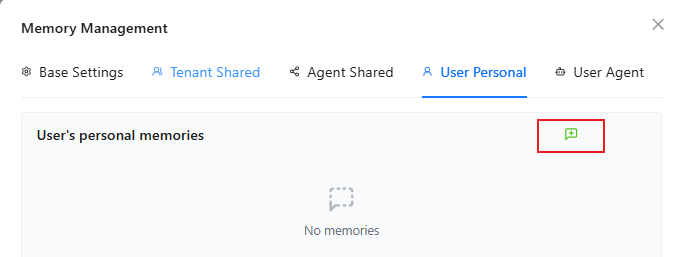🧠Nexent Intelligent Memory System Technical Specification
1. System Architecture Overview
The Nexent Intelligent Memory System is built on an advanced memory storage architecture that provides intelligent agents with persistent context-aware capabilities. Through a multi-layered memory management mechanism, the system achieves cross-conversation knowledge accumulation and retrieval, significantly enhancing the coherence and personalization of human-machine interactions.
Core Technical Features
- Layered Memory Architecture: Four-level memory storage system built on the mem0 framework
- Adaptive Memory Management: Supports both automated and manual memory operation modes
- Cross-Session Persistence: Ensures continuity of knowledge and context across multiple conversations
- Fine-Grained Permission Control: Provides flexible memory sharing strategy configuration
2. Configuration and Initialization
2.1 System Activation
- Access the memory management interface: Click the Memory Management Icon in the upper right corner of the conversation interface
- Enter the System Configuration module for initialization settings
2.2 Core Configuration Parameters
| Configuration Item | Options | Default Value | Description |
|---|---|---|---|
| Memory Service Status | Enable/Disable | Enable | Controls the operational status of the entire memory system |
| Agent Memory Sharing Strategy | Always Share/Ask Me Each Time/Prohibit Sharing | Always Share | Defines whether user authorization consent is required for memory sharing between agents |

3. Layered Memory Architecture
Nexent adopts a four-layer memory storage architecture based on mem0, achieving precise memory classification and retrieval through different scopes and lifecycle management:
3.1 Architecture Layer Details
Tenant Level Memory
- Scope: Organization-wide
- Storage Content: Enterprise-level standard operating procedures, compliance policies, organizational structure, factual information
- Lifecycle: Long-term storage
- Config Role: Tenant Administrator
- Applications: Enterprise knowledge management, standardized process execution, compliance checking
Agent Level Memory
- Scope: Specific Agent
- Storage Content: Professional domain knowledge, skill templates, historical conversation summaries, learning accumulation
- Lifecycle: Consistent with agent lifecycle
- Config Role: Tenant Administrator
- Applications: Professional skill accumulation, domain knowledge sedimentation, experiential learning
User Level Memory
- Scope: Specific User Account
- Storage Content: Personal preference settings, usage habits, common instruction templates, personal information
- Lifecycle: Long-term storage
- Config Role: All Users
- Applications: Personalized services, user experience optimization, preference management
User-Agent Level Memory
- Scope: Specific Agent under Specific User Account
- Storage Content: Collaboration history, personalized factual information, specific task context, relationship models
- Lifecycle: Consistent with agent lifecycle
- Config Role: All Users
- Applications: Deep collaboration scenarios, personalized tuning, task continuity maintenance
3.2 Memory Priority and Retrieval Strategy
Memory retrieval follows the following priority order (from high to low):
- Tenant Level → Basic facts
- User-Agent Level → Most specific context information
- User Level → Personal preferences and habits
- Agent Level → Professional knowledge and skills
4. Operation Modes and Functional Interfaces
4.1 Automated Memory Management
- Intelligent Extraction: Automatically identifies key factual information in conversations and generates memory entries
- Automatic Context Embedding: Agents automatically retrieve the most relevant memory entries and implicitly embed them in conversation context
- Incremental Updates: Supports progressive updates, supplementation, and automatic cleanup of memory content
4.2 Manual Memory Operations
Adding Memory
- Click the green plus button, input text, then click the checkmark to add a memory entry (maximum 500 characters)

Deleting Memory
- Click the red cross button, then click confirm in the popup confirmation dialog to delete all memory entries under a specific Agent group
- Click the red eraser button to delete a specific memory entry

4.3 Memory Management Best Practices
- Atomicity Principle: Each memory entry should contain concise, single, clear factual information
- Temporal Management: Regularly clean up outdated or no longer relevant memory entries to maintain the timeliness and accuracy of the memory database
- Privacy Protection: Sensitive information should be avoided from being shared at the tenant level or agent level
